Abstract
The value of cultural and serological procedures in diagnosing gonococcal and chlamydial infections was investigated in 85 women who had provisional diagnoses of pelvic inflammatory disease. The correlation between certain clinical variables and the absence or presence of such infections was also studied. In 46 the diagnosis of acute salpingitis was verified by laparoscopy. The laboratory and clinical findings in the patients with acute salpingitis were compared with those in the remaining 39 women in whom laparoscopy did not show signs of inflammation. Salpingitis was considered to be gonococcal if Neisseria gonorrhoeae was isolated or a fourfold or more change in titre of antibodies to gonococcus pilus antigen was found. The diagnosis of chlamydial salpingitis was based on the isolation of Chlamydia trachomatis, a fourfold or more change in titre of IgG antibodies to or from a titre of greater than or equal to 1/256, or the presence of IgG antibodies at a titre of greater than or equal to 1/512. Patients with chlamydial salpingitis had less severe symptoms but a more protracted course of disease than patients with gonococcal salpingitis or with acute salpingitis not associated with the two pathogens.
Full text
PDF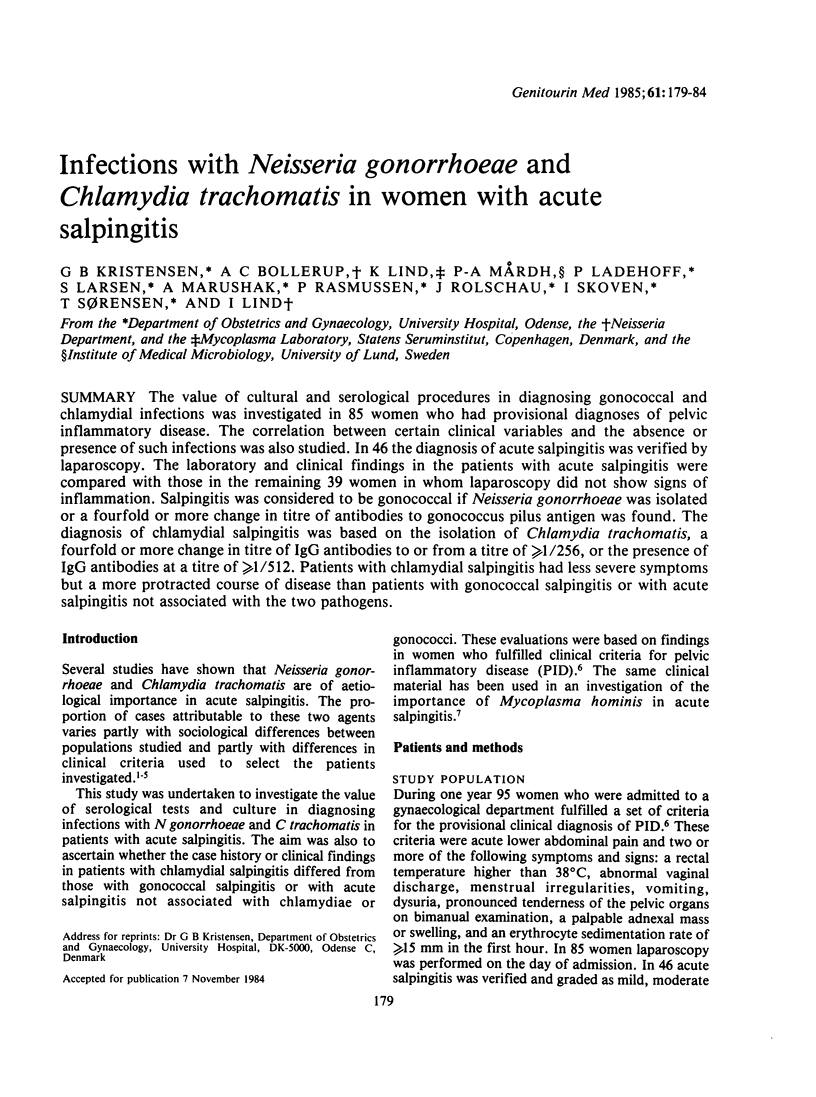
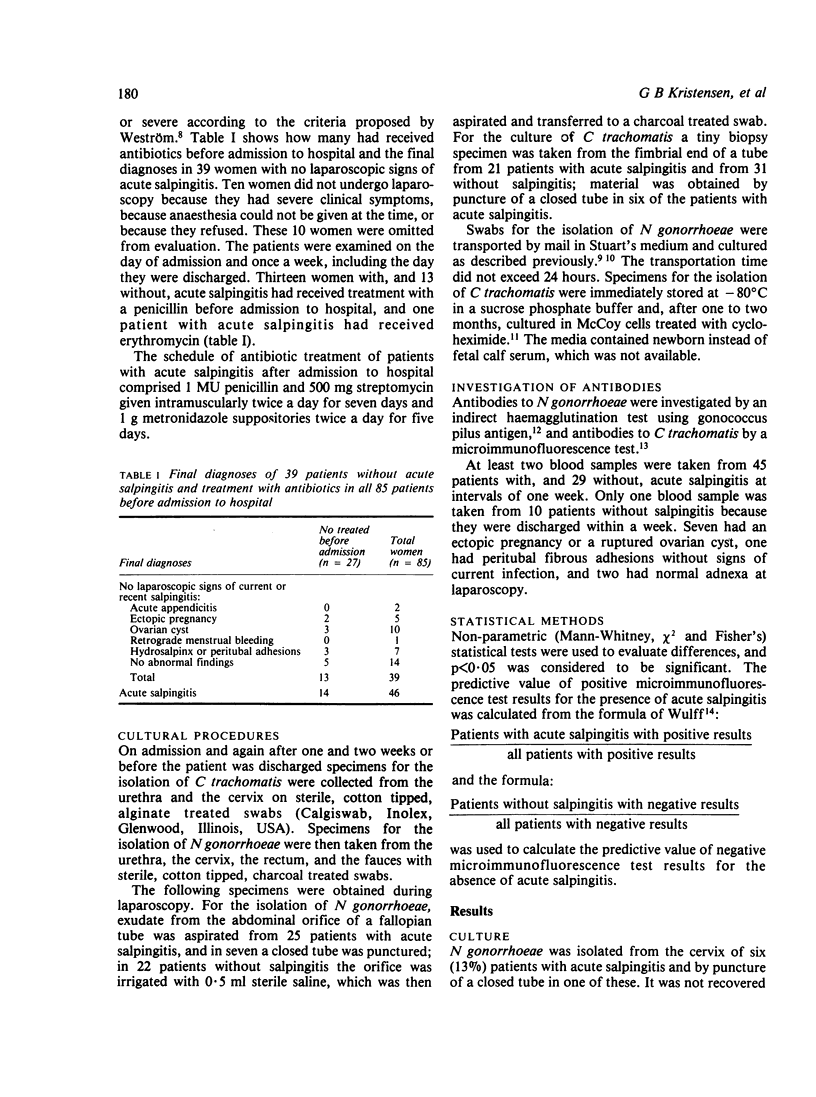
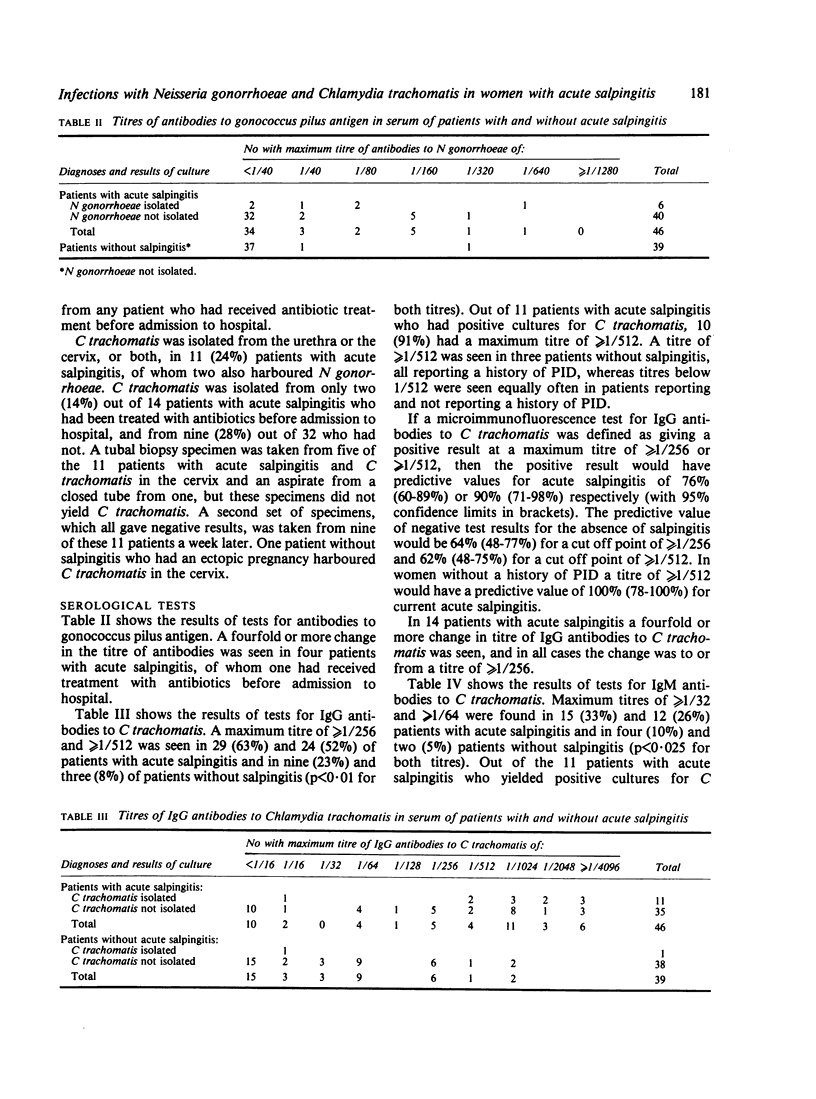
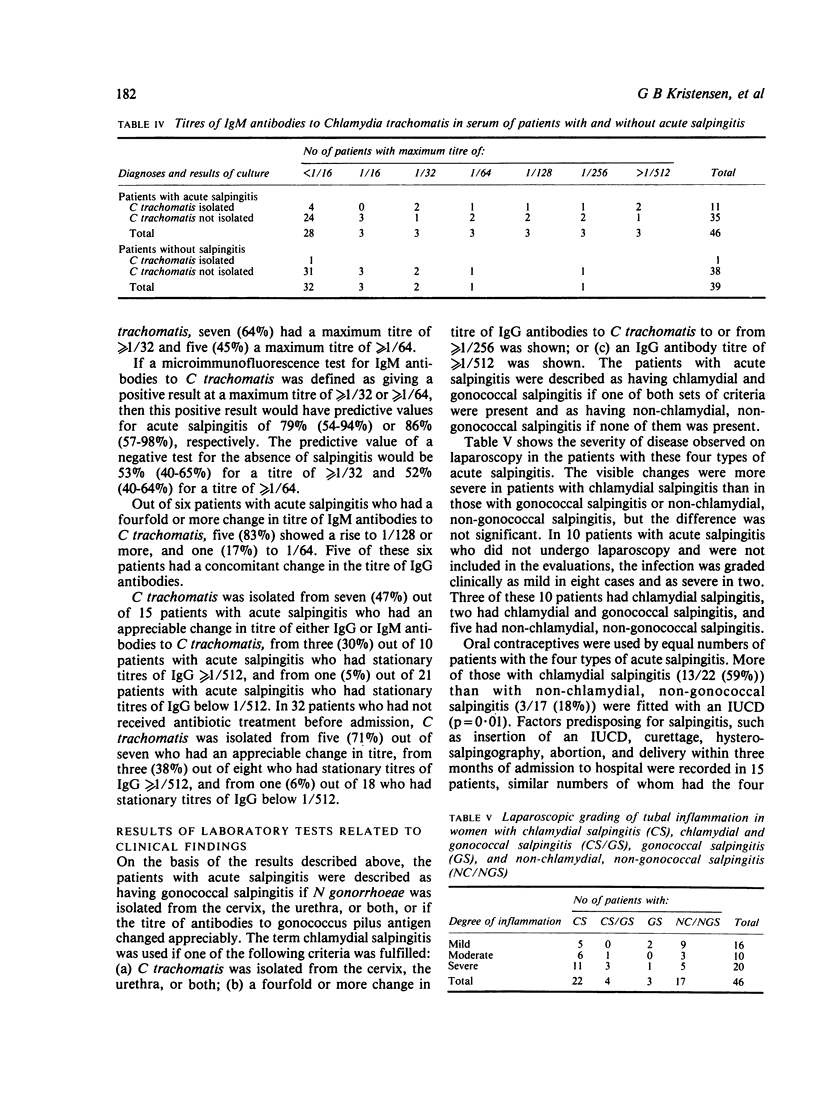
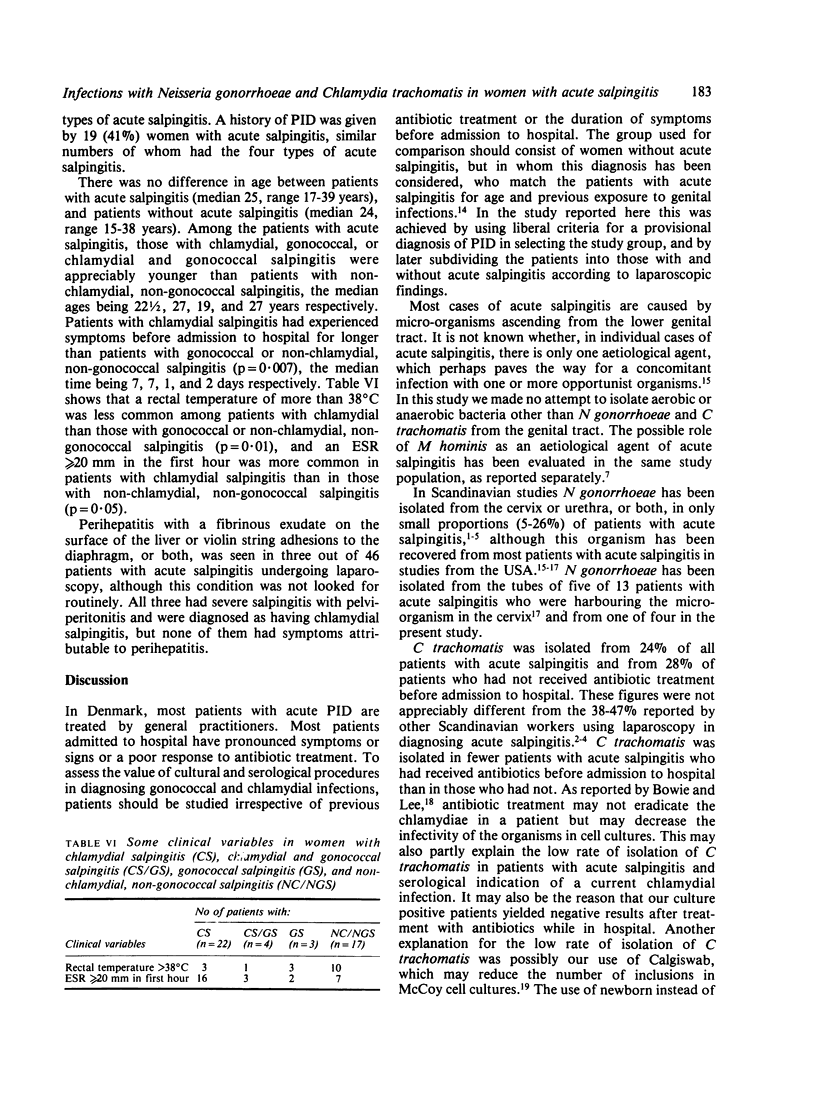
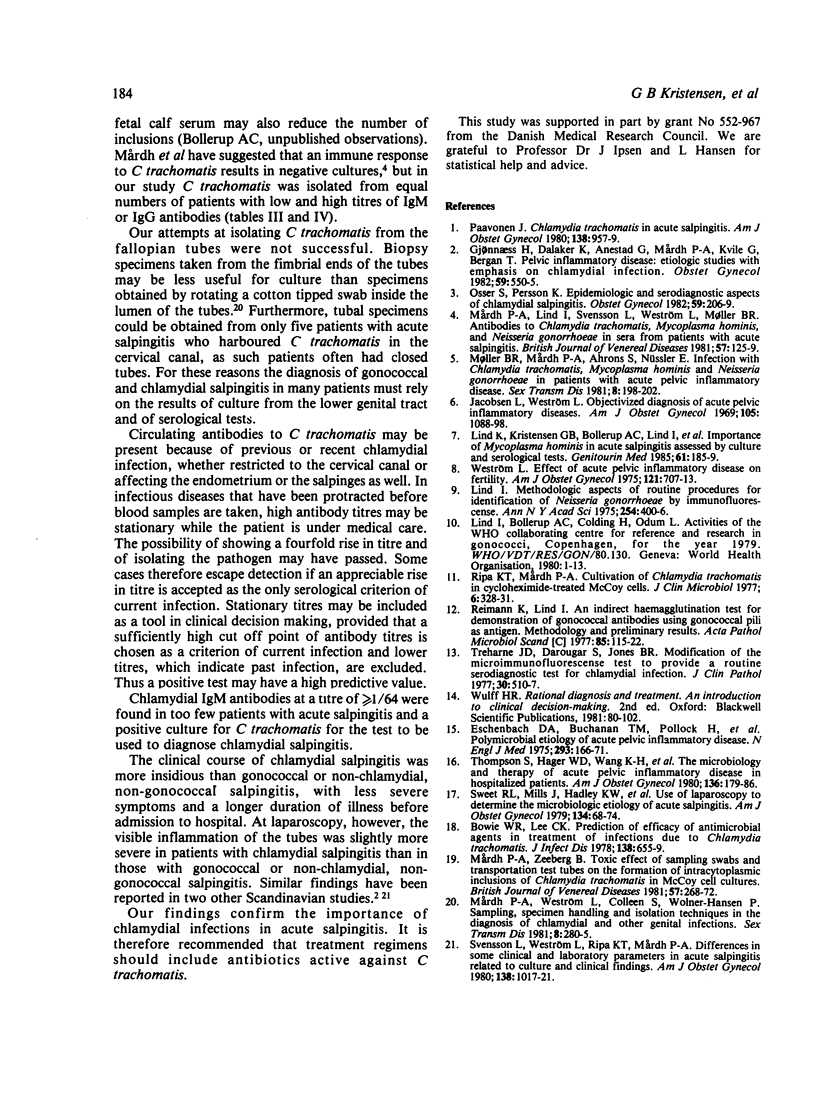
Selected References
These references are in PubMed. This may not be the complete list of references from this article.
- Bowie W. R., Lee C. K., Alexander E. R. Prediction of efficacy of antimicrobial agents in treatment of infections due to Chlamydia trachomatis. J Infect Dis. 1978 Nov;138(5):655–659. doi: 10.1093/infdis/138.5.655. [DOI] [PubMed] [Google Scholar]
- Eschenbach D. A., Buchanan T. M., Pollock H. M., Forsyth P. S., Alexander E. R., Lin J. S., Wang S. P., Wentworth B. B., MacCormack W. M., Holmes K. K. Polymicrobial etiology of acute pelvic inflammatory disease. N Engl J Med. 1975 Jul 24;293(4):166–171. doi: 10.1056/NEJM197507242930403. [DOI] [PubMed] [Google Scholar]
- Gjønnaess H., Dalaker K., Anestad G., Mårdh P. A., Kvile G., Bergan T. Pelvic inflammatory disease: etiologic studies with emphasis on chlamydial infection. Obstet Gynecol. 1982 May;59(5):550–555. [PubMed] [Google Scholar]
- Jacobson L., Weström L. Objectivized diagnosis of acute pelvic inflammatory disease. Diagnostic and prognostic value of routine laparoscopy. Am J Obstet Gynecol. 1969 Dec 1;105(7):1088–1098. doi: 10.1016/0002-9378(69)90132-x. [DOI] [PubMed] [Google Scholar]
- Lind I. Methodologic aspects of routine procedures for identification of Neisseria gonorrhoeae by immunofluorescence. Ann N Y Acad Sci. 1975 Jun 30;254:400–406. doi: 10.1111/j.1749-6632.1975.tb29191.x. [DOI] [PubMed] [Google Scholar]
- Lind K., Kristensen G. B., Bollerup A. C., Ladehoff P., Larsen S., Marushak A., Rasmussen P., Rolschau J., Skoven I., Sørensen T. Importance of Mycoplasma hominis in acute salpingitis assessed by culture and serological tests. Genitourin Med. 1985 Jun;61(3):185–189. doi: 10.1136/sti.61.3.185. [DOI] [PMC free article] [PubMed] [Google Scholar]
- Märdh P. A., Lind I., Svensson L., Weström L., Møller B. R. Antibodies to Chlamydia trachomatis, Mycoplasma hominis, and Neisseria gonorrhoeae in sera from patients with acute salpingitis. Br J Vener Dis. 1981 Apr;57(2):125–129. doi: 10.1136/sti.57.2.125. [DOI] [PMC free article] [PubMed] [Google Scholar]
- Mårdh P. A., Zeeberg B. Toxic effect of sampling swabs and transportation test tubes on the formation of intracytoplasmic inclusions of Chlamydia trachomatis in McCoy cell cultures. Br J Vener Dis. 1981 Aug;57(4):268–272. doi: 10.1136/sti.57.4.268. [DOI] [PMC free article] [PubMed] [Google Scholar]
- Møller B. R., Mårdh P. A., Ahrons S., Nüssler E. Infection with Chlamydia trachomatis, Mycoplasma hominis and Neisseria gonorrhoeae in patients with acute pelvic inflammatory disease. Sex Transm Dis. 1981 Jul-Sep;8(3):198–202. [PubMed] [Google Scholar]
- Osser S., Persson K. Epidemiologic and serodiagnostic aspects of chlamydial salpingitis. Obstet Gynecol. 1982 Feb;59(2):206–209. [PubMed] [Google Scholar]
- Paavonen J. Chlamydia trachomatis in acute salpingitis. Am J Obstet Gynecol. 1980 Dec 1;138(7 Pt 2):957–959. doi: 10.1016/0002-9378(80)91086-8. [DOI] [PubMed] [Google Scholar]
- Reimann K., Lind I. An indirect haemagglutination test for demonstration of gonococcal antibodies using gonococcal pili as antigen. I. Methodology and preliminary results. Acta Pathol Microbiol Scand C. 1977 Apr;85(2):115–122. doi: 10.1111/j.1699-0463.1977.tb03620.x. [DOI] [PubMed] [Google Scholar]
- Ripa K. T., Mårdh P. A. Cultivation of Chlamydia trachomatis in cycloheximide-treated mccoy cells. J Clin Microbiol. 1977 Oct;6(4):328–331. doi: 10.1128/jcm.6.4.328-331.1977. [DOI] [PMC free article] [PubMed] [Google Scholar]
- Svensson L., Weström L., Ripa K. T., Mårdh P. A. Differences in some clinical and laboratory parameters in acute salpingitis related to culture and serologic findings. Am J Obstet Gynecol. 1980 Dec 1;138(7 Pt 2):1017–1021. doi: 10.1016/0002-9378(80)91099-6. [DOI] [PubMed] [Google Scholar]
- Sweet R. L., Mills J., Hadley K. W., Blumenstock E., Schachter J., Robbie M. O., Draper D. L. Use of laparoscopy to determine the microbiologic etiology of acute salpingitis. Am J Obstet Gynecol. 1979 May 1;134(1):68–74. doi: 10.1016/0002-9378(79)90798-1. [DOI] [PubMed] [Google Scholar]
- Thompson S. E., 3rd, Hager W. D., Wong K. H., Lopez B., Ramsey C., Allen S. D., Stargel M. D., Thornsberry C., Benigno B. B., Thompson J. D. The microbiology and therapy of acute pelvic inflammatory disease in hospitalized patients. Am J Obstet Gynecol. 1980 Jan 15;136(2):179–186. doi: 10.1016/0002-9378(80)90592-x. [DOI] [PubMed] [Google Scholar]
- Treharne J. D., Darougar S., Jones B. R. Modification of the microimmunofluorescence test to provide a routine serodiagnostic test for chlamydial infection. J Clin Pathol. 1977 Jun;30(6):510–517. doi: 10.1136/jcp.30.6.510. [DOI] [PMC free article] [PubMed] [Google Scholar]


